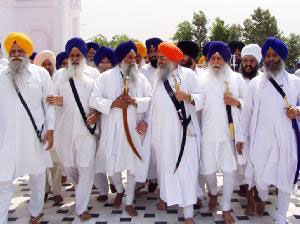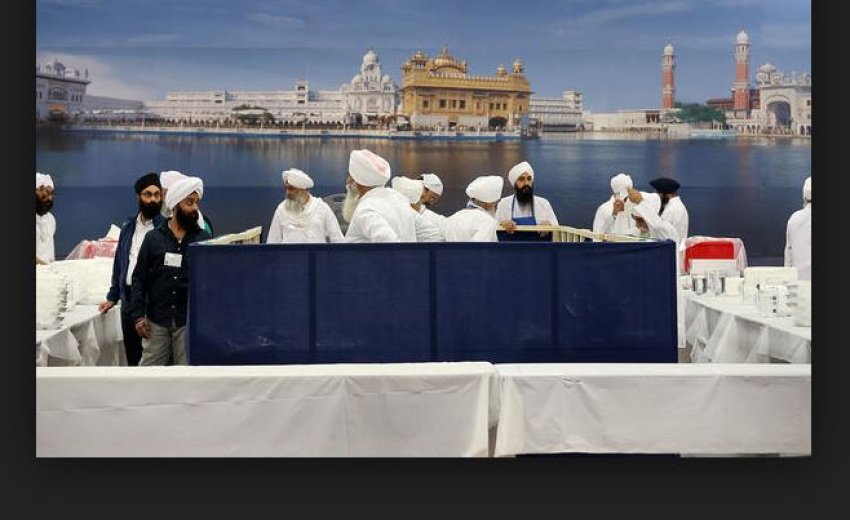 Newspapers in Panjab have been buzzing about the recent proposal by the Sikhs in Haryana to form their own Gurdwara political body. However, the Chief Minister of Punjab, Parkash Singh Badal, and head of the Akali Dal has been on a warpath trying to prevent such a move. Badal even went so far as to give a sort of veiled threat of the outcome by such a move:
Newspapers in Panjab have been buzzing about the recent proposal by the Sikhs in Haryana to form their own Gurdwara political body. However, the Chief Minister of Punjab, Parkash Singh Badal, and head of the Akali Dal has been on a warpath trying to prevent such a move. Badal even went so far as to give a sort of veiled threat of the outcome by such a move:
“We are a peace-loving community and hope that attempts to open a fresh festering wound in the country in Punjab would be dropped. The whole of country is already up in flames and it can easily do without another trouble spot in Punjab along the lines of Jammu and Kashmir.” [link]
The problem with forming an opinion or even coming to terms with the situation is the layers of political intentions and motives. In a move to somewhat demystify and explain the situation, I write this post.
The SGPC’s History, Role, and Functioning
The Shiromani Gurdwara Parbandhak Committee (SGPC) had its inception as a conglomerate of a number of different groups during the Gurdwara liberation movements and morchas during the 1920s. The organization received official recognition and was constituted under the British Raj with the Sikh Gurdwara Act, 1925.The Gurdwara Act covered the Gurdwaras in historical Punjab.
However, with the Partition of 1947 and subsequent partitions of East Punjab (into Haryana and Himachal Pradesh), the Act was reorganized and the SGPC maintained its control over Gurdwaras in Punjab, Haryana, Himachal Pradesh, and Chandigarh.
Other Gurdwara boards have been constituted in other areas in India outside Punjab as well as in foreign countries – most notably the Pakistan Gurdwara Parbandhak Committee (PGPC) and the fledgling American Gurdwara Parbandhak Committee (AGPC).
The stakes for keeping a consolidated SGPC are high. Along with the maintenance of the Gurdwaras in these regions, the SGPC maintains a number of colleges, schools, orphanages, and hospitals. The yearly budget is in the range of RS 220 crore (2.24 billion Rs, or 50 million dollars) netted through annual donations.
The SGPC has always been linked to the Akali Dal political party. During the early part of the twentieth century, it was generally the same activists and overlap that served in both the political and religious spheres. Such congruity was acceptable to the Sikh masses due to the wedded conception of miri and piri.
The Current Mess
However, as Akali Dal politics has entered the hands of career politicians and democratic politics has led to the creation of a patrimonial dynasty – the Badal Famiy – the budget of the SGPC has often been used (and as many would decry misused) to support political functions and electioneering of the Akali Dal. (Free alcohol is always one way the funds are used to “get-out-the-vote” in both rural and urban Punjab. The thought that Gurdwara funds are used in such ways should trouble the minds of many Sikhs.)
With such a base of revenue from Gurdwara donations, the Akali Dal has remained a viable political force, despite severe machinations by the Congress Party in Punjab and the Congress Party at Delhi, most evident by the number of times the Akali state government was dissolved and President’s Rule imposed (1951, 1966, 1968, 1971, 1977, 1980, 1983, 1987).
Despite its control, many of the most well-meaning Sikhs have questioned the Akali Dal’s abuse of Gurdwara funds, especially as Badal has tried to shed the Sikh identity of the Akali Dal and has unilaterally proclaimed it a “Punjabi Party.” These Sikhs criticize the lack of parchar and the total failing of the SGPC in utilizing community resources in providing religious education about the proud Sikh tradition. The original use of the funds has taken a backseat to party politics.
In addition to these well-meaning Sikhs, members of the Congress Party in Punjab have seen a political opening to break the Akali Dal’s stranglehold on SGPC funds. While some Congress Party members may undoubtedly believe that greater local control of funding may better serve local Sikh communities, many of their members seem to have motives that are more akin to political advantage than the Qaum’s well-being. As the Congress Party is a national party, its Punjab chapter can tap into huge fund pools from the national war chest. The Akali Dal as a strictly regional party has no such advantage. The Akali Dal’s monetary power comes through the use of the SGPC funds.
The current call came out as the Congress Party in Haryana had made the issue of a separate Gurdwara Committee as part of its campaign promises to the sizeable Sikh community in Haryana. The Sikhs in Haryana do seem to want to control their own finances and found a willing partner in the Congress Party.
Despite the SGPC’s claim that more money goes back to Haryana than what is actually brought in,few are convinced.
The present Congress Party Chief Minister in Haryana, Bhupinder Singh Hooda, began making calls that procedures for a separate Gurdwara Board in Haryana should commence. Badal and his Akali Dal reacted sharply.
With political stakes so high for himself and his party, it is clear why Parkash Badal would give a veiled threat to Delhi Sarkar. For the time being (due to the political violence in Kashmir) the Congress Party in Haryana seems to be poised to back down. Badal’s Akali Dal began mobilizing for a show-of-force in Karnal (located in Haryana). The Congress Party leaders (including Sonia Gandhi) had no desire to create another problem with Kashmir already burning (plus even more recent violence in Orissa). Thus it seems for the time being the Prime Minister’s Office (Manmohan Singh) has backed down and called for Chief Minister Hooda to suspend such actions for the time being.
While my primary purpose was to create a context for people to understand the situation, before concluding it may merit importance to deconstruct Badal’s threat as well as begin reflecting on the future of the SGPC.
Seeing Through Parkash Badal’s Game
Badal as the head of the patrimonial-dynasty in Panjab has the allegiance of many coteries. It is through their allegiance to Badal that they gain political, economic, and social advantages. Rivals in the past (including the now deceased Gurcharan Singh Tohra, Jagdev Singh Talwandi, Dhindsa, etc.) have all been sidelined. Although these patrimonial-dynasties attempt to accrue benefits for their ‘banday,’ they pale in comparison to that of the Badal clique. This is the reason many that belonged to these former groups have now aligned themselves with Badal. The Congress Party functions in much the same way as those that are attached to Patiala’s Captain Amrinder Singh, Rajinder Kaur Bhattal, etc.
With Badal’s political-economic base at stake, he had to make a show of force. As many of his ‘banday’ would also understand the significance of the move by Haryana’s Chief Minister and their stake in Badal maintaining his hegemonic control of the SGPC’s funds, they would have rushed to Karnal. How many would have showed up is obviously a ‘what if’ question that we will never be able to answer. However, I will surmise that it isn’t as large as Badal thinks. Inevitably Badal would then have had to move to link his issue of the SGPC with ongoing issue of Dera Sacha Sauda and its chief Ram Rahim. As Dera Sacha Sauda’s headquarters are in Haryana and he enjoys the protection of the Congress Chief Minister, for Badal to make this link would have been rather easy.
This issue still has the potential to remain explosive and Badal’s initial mobilization of his Akali Dal ‘banday’ would be the trigger for the greater Sikh masses to also rally around the cause against Ram Rahim. Badal, empowered by his ability to control the masses through manipulation of the SGPC and the Jathedar post as well as his unceremonious removal of Vedanti with the even more pliable Gurbachan Singh, has emboldened him to believe that he can continue to manipulate the situation through a combination of allowing the Sikh community’s anger and steam to begin boiling, but then applying the lid as he sees fit. This is the position that Badal has always wished to present himself to the Central Government. Thus unwittingly many other Sikh groups play into Badal’s trap. For the past three decades Badal has played this game superbly, the only exception came with the rise of Bhindranwale and the events surrounding the Ghallughara of 1984. From 1984-1997, Badal lost his footing and it was not until the Central Government decimated the Sikh youth and eliminated all opposing voices that Badal was again allowed to reassert his hegemony upon the Sikh community.
It is for community members that desire to break the grip of this boa-constrictor that they must begin to think of ways to discredit Badal and not to unwittingly help in maintaining his hegemony.
The Future of the SGPC
The second issue that I would like to open up is the future of the SGPC.
While many Sikhs remain focused on issues related to the Jathedar of the Akal Takht, the far more critical institutional changes (with the present set-up) can only come through the SGPC. The Jathedar-obsession clouds the ability for change to occur. We need to move away from individual-centered politics and the position of the Jathedar is in many ways the worst manifestation of this.
During the 1980s, Sikh activists did not believe that they could break Badal’s dominance of the SGPC and thus attempted to torpedo the process and leapfrog the SGPC completely by calling for a ‘Sarbat Khalsa.’ I do believe that the Sarbat Khalsa is a democratic-based institution that needs to be revisited and reignited in the mind of the Sikhs. The move towards collective democratic decision-making is critical for the future of the Sikhs.
However, concurrently with reigniting the flame of the Sarbat Khalsa, Sikh activists need to break Badal’s dominance of the SGPC. The SGPC is the key to his patrimonial abilities and thus the key to his levers of power. It is for this reason that he suspended SGPC elections during the 1980s and 1990s. However, Sikh activists that have the community’s best interest at heart must contest Badal’s candidates to break his stranglehold. Instead of even focusing on the general political elections, they should only concentrate on the SGPC elections through demands for greater accountability, transparency, and democracy. If they do so, they will eventually be able to gain control of this key institution (although Badal will try even greater chicaneries to maintain his hegemony). After doing so, I hope that they move then to either dismantle the SGPC (through affording greater local control of Sangat funds those local Sangats) or to radically reorganize the role of the SGPC with a far more democratic process that is far more receptive and adaptive to the community’s needs. In some ways, they should move to subordinate the SGPC to the Sarbat Khalsa. The SGPC must become relevant again, rather than only a cash cow. If Sikh activists only attempt to control the SGPC so that they may create new patrimonial-dynasties than the same problem will continue to haunt the Sikh community.
